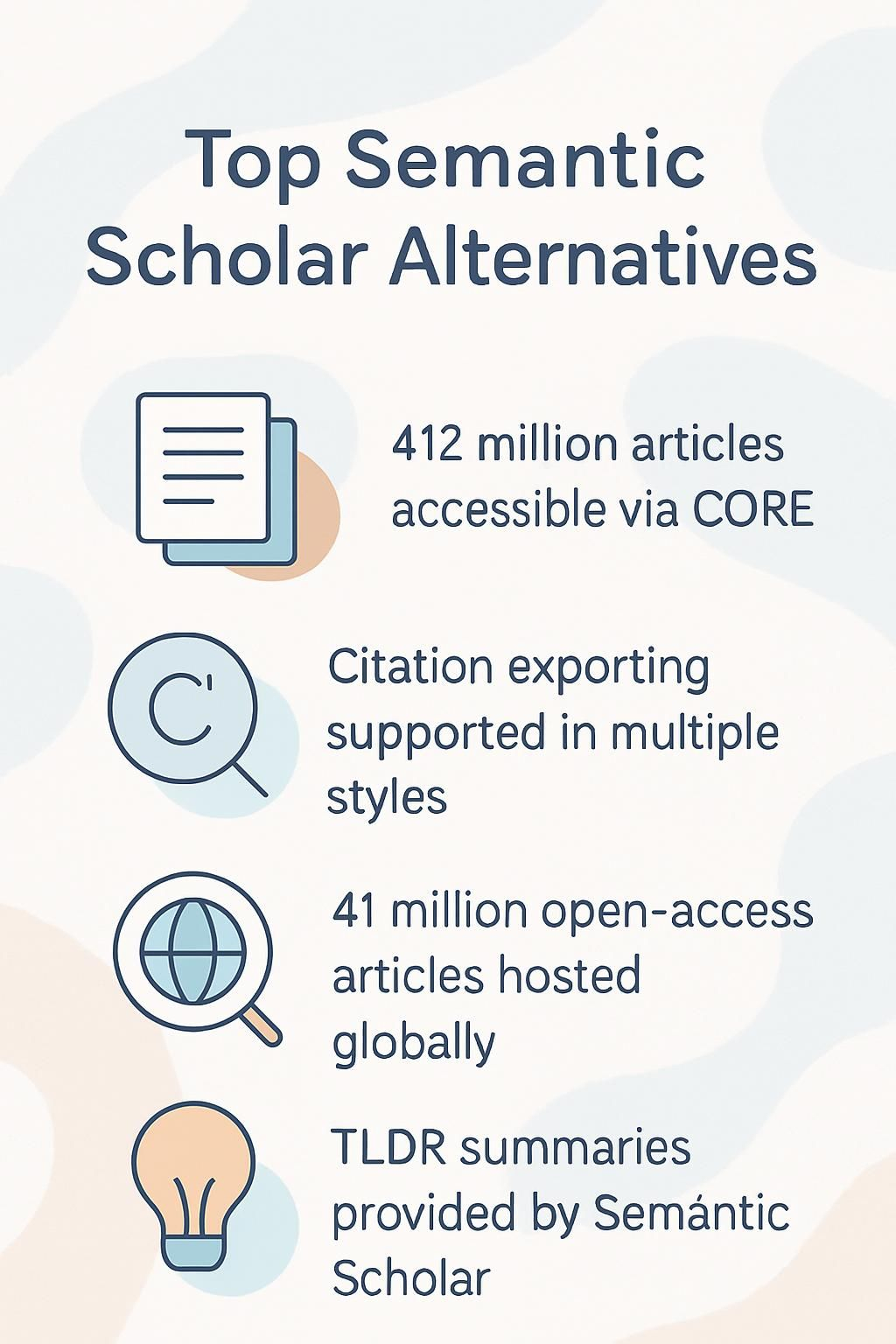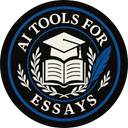Finding the right tool for academic research can feel frustrating. While Semantic Scholar is popular, it may not fit everyone’s needs. This guide explores alternatives that offer features like citation tracking, AI-powered tips, and open-access content.
Keep reading to find your perfect match!
Key Takeaways
- Many tools like Google Scholar, CORE, and BASE offer powerful search filters for precise academic searches. CORE provides access to 412 million articles, with 295 million full-text open-access. BASE supports filtering by language, license type, and more.
- Citation tracking is key for researchers. Platforms like Scopus provide advanced metrics like h-index. Google Scholar supports citation exporting in multiple styles (APA, MLA). Elicit offers export options in RIS and CSV formats.
- Open-access content bridges paywall gaps. CORE focuses on free resources with a global reach of 41 million hosted articles. SpringerLink also provides some free journals and books.
- AI-powered tools improve research speed. Semantic Scholar delivers TLDR summaries; Elicit organizes results into tables; Scispace boosts precision through semantic queries.
- Budget matters when choosing a tool. Free options include CORE and Connected Papers’ basic version while paid tools like Scopus require subscriptions but offer deeper features for serious research needs.

Key Features to Look for in Semantic Scholar Alternatives
Finding the right research tool takes careful thought. Keep an eye out for features that make your work faster and easier.
Search and filtering capabilities
Advanced search filters make finding scholarly articles faster and easier. Tools like Google Scholar include Boolean operators and year filters for precise queries. BASE supports over 20 languages, offering options by license type, access type, and Dewey Decimal Classification (DDC).
CORE stands out with searches by institution, subject, preprints, hybrids, or open access.
Platforms like Science.gov provide unique filters for agencies or grant types. OpenRead offers real-time database updates alongside advanced filtering tools. Sourcely lets researchers filter results by relevance or keyword while focusing on open-access journals.
The right filter can save hours of research work.
Citation tracking
Citation tracking helps researchers follow how often and where a paper is cited. Google Scholar offers features for tracking citations with exports in APA, MLA, Chicago, Harvard, Vancouver, RIS, and BibTeX formats.
Semantic Scholar uses machine learning to rank citations by relevance. This makes it easier to find impactful papers quickly.
Scispace links with Zotero for citation management needs. Elicit supports exporting citations in BIB, RIS, and CSV formats. Scholarcy builds bibliographies directly in Word files. Sourcely allows easy export of references in popular styles like APA or MLA.
These tools save time while keeping your academic writing organized and accurate!
Open access content availability
CORE hosts 412 million articles, with 295 million offering full-text access for free. BASE curates over 400 million academic records, and about 60% are open to everyone without restrictions.
These platforms bridge gaps caused by paywalls.
ScienceDirect includes around 3.8 million open-access articles from journals like Elsevier. SpringerLink provides thousands of journals and books, many available at no cost. Tools like these make it easier to study without shelling out cash.
Integration with other research tools
Having access to open content is useful, but connecting your research with other tools makes the process smoother. Scispace works with Zotero and offers a Chrome extension for added flexibility.
Scholarcy goes further, integrating with Google Drive while providing exports for reference managers like Zotero.
Paperpile links seamlessly with Google Scholar. This helps when managing references or finding related articles faster. Tools that work together save time and eliminate manual effort, making research less of a headache.
AI-powered recommendations
AI recommendations make research faster and smarter. Semantic Scholar, for example, delivers TLDR summaries alongside personalized feeds. Tools like Elicit use natural language processing to sort results by themes or organize them in tables.
Scholarcy takes it up a notch with AI-generated flashcards that help users grasp material quickly.
Scispace’s Copilot supports 75+ languages while boosting search precision through semantic queries. This ensures users find deeply relevant academic papers without trudging through irrelevant results.
Such features improve workflows for literature reviews, data visualization tasks, and even inline citation tracking.
Next: Google Scholar features and highlights
Google Scholar
Google Scholar is a well-known tool for finding research papers, theses, and court opinions. It offers simple access to academic content across many fields.
Features & Highlights (Google Scholar)
This search engine is free and covers about 200 million articles. It shows abstracts, references, citations, and PDF links when available. Users can filter by year or use Boolean operators for more precise results.
Advanced search options make finding research papers quick and efficient.
You can connect it with your institutional library to access full texts of restricted content. It supports citation management tools like Paperpile, which helps organize sources easily.
Its AI-powered system suggests related articles based on user searches.
Pros & Cons (Google Scholar)
Google Scholar is a widely-used academic research tool, loved for its simplicity and extensive coverage. Below is a detailed breakdown of its advantages and disadvantages.
| Pros | Cons |
|---|---|
| Free to access, making it convenient for all users. | Search results are capped at 1,000, which can limit deeper exploration. |
| Covers a massive range of topics, with millions of academic papers available. | Lacks a dedicated filter for peer-reviewed content. |
| Tracks citations effectively, helping researchers monitor their impact. | Metadata is sometimes inconsistent, leading to errors in organization. |
| Integrates well with institutional libraries for additional resources. | Incomplete coverage of specialized or restricted databases can cause gaps in research. |
| Supports multiple citation formats for effortless referencing. | Access to full-text articles often depends on external publishers or subscriptions. |
Scopus
Scopus is a big database for academic articles and research. It helps track citations, find related studies, and analyze data quickly.
Features & Highlights (Scopus)
Scopus offers advanced search tools for academic content. Users can filter results by author, year, subject area, and document type. It supports text and data mining, making research faster and precise.
It tracks citations to show an article’s impact with metrics like the h-index. Covering thousands of peer-reviewed journals across disciplines, it provides access to both current studies and historical archives.
Integration with citation managers simplifies bibliography creation for academic writing projects. While highly useful, Scopus requires a paid subscription for full access; open-access options are limited.
Pros & Cons (Scopus)
Scopus is a heavyweight in the academic research world. Known for its vast library and powerful tools, it’s a go-to for researchers. Let’s break down its strengths and weaknesses.
| Pros | Cons |
|---|---|
| – Extensive citation tracking for bibliometric analysis. | – Requires a subscription; not free for all users. |
| – Covers an enormous number of peer-reviewed journals. | – May exclude some open-access articles. |
| – Advanced search functionalities for academics. | – Limited access for those without institutional ties. |
| – Integration with other tools in research workflows. | – Not highlighted for smart AI-based research suggestions. |
For researchers exploring full-text access, Google Scholar might be the next interesting option to consider.
JSTOR
JSTOR offers a rich library of academic journals, books, and primary sources. Its archive is perfect for in-depth literature reviews or social science research.
Features & Highlights (JSTOR)
The platform holds over 10 million documents. It includes 2,900 journals and 300,000 books. More than 3 million authors publish content yearly. Users can access primary and secondary sources, making it great for deep research.
Researchers enjoy advanced search tools to filter results by type or field. Its focus on humanities and social sciences stands out, though select science fields are available too. Open-access materials exist but require a subscription for full content.
Each month, about 24 million users explore JSTOR’s library with over 185 million downloads per year!
Pros & Cons (JSTOR)
Transitioning from JSTOR’s features to its practical advantages and limitations, it’s essential to dissect its pros and cons. Here’s a clear breakdown for better understanding:
| Pros | Cons |
|---|---|
– Massive archive of journals and books. – Covers many subjects, from arts to science. – Trusted by academics for decades. – High-quality, peer-reviewed content. – Provides a stable source for citations. – Long-term preservation of older publications. | – Subscription fees are required for most content. – Limited open access availability. – Lacks AI-powered search tools. – Integration with citation managers is weak. – May not have the newest tech-related research. – Search options aren’t very advanced. |
This table lays it all on the table, pun intended. It gives a snapshot of what JSTOR excels at and where it falls short.
ResearchGate
ResearchGate acts as a hub for scholars, letting users connect and share studies. It offers tools for collaboration, making research feel less isolated.
Features & Highlights (ResearchGate)
Researchers can share their publications, datasets, and findings directly on the platform. It supports uploading full-text PDFs when allowed, making it easier to access open content.
The site includes tools for collaboration through community features like Q&A forums and topic follow options. Users can track publication metrics and view detailed researcher profiles.
Following specific researchers or topics ensures updates straight to your inbox without hassle.
Pros & Cons (ResearchGate)
ResearchGate makes sharing studies and connecting with experts simple. It offers free access to some features, like community discussions and limited full-text resources. Users can create profiles that display their research metrics, which helps track academic contributions.
Access to full articles depends on whether authors upload them, so not all content is available. Citation management options are basic, giving researchers fewer tools for organizing sources. Its coverage across fields can be inconsistent too. Unlike other platforms, it lacks strong AI-powered search or deep text analysis capabilities.
Elicit
Elicit uses AI to help researchers find and organize papers quickly. It simplifies data gathering, saving you time for deeper analysis.
Features & Highlights (Elicit)
Elicit simplifies academic research with its AI-powered tools. It handles natural language searches effectively, turning results into easy-to-read data tables. The platform boasts access to 125 million academic papers, covering a wide range of topics.
Researchers can spot themes quickly and organize findings without much hassle.
Export options include RIS, CSV, and BIB formats for flexibility in citation management. The basic plan offers 5,000 free credits monthly while premium plans start at $10 per month annually or $12 for monthly billing.
Advanced users can choose the Pro plan at $49 per month or pay $499 yearly. This tool saves an average of five hours weekly on research tasks by streamlining processes efficiently.
Pros & Cons (Elicit)
Elicit uses AI to find research papers and answers faster. Its natural language search makes queries easier, saving up to 50% of time or costs. Users rate it highly at 4.6 out of 5 for its helpful features like theme detection and export options for data.
It lacks built-in citation management, which might frustrate some researchers who rely on reference tools. Free credits are limited, and advanced functions require payment. It also focuses more on organizing data than offering full-text access to papers, which could be a drawback for users needing complete articles frequently.
Connected Papers
Connected Papers makes exploring academic papers a breeze. It maps related articles visually, saving time and effort in finding relevant research.
Features & Highlights (Connected Papers)
Connected Papers creates a visual map of research papers. It organizes topics and shows their relationships clearly. Users can explore academic networks, including citations and influence paths, with ease.
The tool helps in idea generation by displaying related articles graphically. Researchers use it to spot knowledge gaps during literature reviews. Its free version has limited features, while paid upgrades unlock more options.
Unlike Semantic Scholar or Scopus, this platform focuses less on full-text access or citation export tasks but excels at mapping ideas visually.
Pros & Cons (Connected Papers)
It offers a simple way to explore academic work visually. You can map connections between papers, making literature reviews feel less overwhelming. It helps researchers understand trends and gaps in knowledge quickly. The free version is handy for basic tasks like scanning related articles.
Its database is not as broad as some other tools like Google Scholar or Scopus. Features for citation management or export are absent, which may frustrate detailed users. Open access content isn’t the main focus here, limiting options slightly for researchers on tight budgets. Paid upgrades might be needed if advanced mapping features are essential.
Next up: CORE!
CORE
CORE is a free resource for open access research papers. It connects you to millions of academic articles with ease.
Features & Highlights (CORE)
CORE indexes over 412 million articles from 13,000 providers across more than 150 countries. It gives researchers access to 295 million free, full-text documents. Out of these, 41 million are directly hosted on the platform for quick retrieval.
Advanced filtering tools help users sort content by subject, institution, or publication type such as preprints or hybrid works. Researchers can also find open-access materials with ease.
CORE supports metadata validation and improves academic data quality through enhancements. With over 20 million monthly users worldwide, it stands as a key research tool in academic publishing systems.
Pros & Cons (CORE)
CORE offers the largest open-access scholarly database globally. It provides free access to full-text articles, research papers, and data sets. Its advanced search features simplify finding relevant studies. The platform is completely free with no subscription fees or credit card required.
On the downside, it lacks citation management tools for organizing references efficiently. Exporting citations is not available either. Paywalled or subscription-only journals are often excluded from its database. Integration with external reference managers like Zotero or EndNote is also limited. Its focus is primarily on open-access content while offering less in AI-powered recommendations for users seeking personalized suggestions.
How to Choose the Right Alternative for Your Needs
Finding the right tool depends on your research habits and priorities. Think about what features matter most, like citation tracking or open access content.
Matching features to research requirements
Make sure the tool supports your research goals. For citation-heavy work, check if it handles APA, MLA, or Chicago styles. If you need literature reviews, focus on databases with smart analysis and AI summarization.
Tools like Elicit might help in streamlining data extraction tasks.
Think about database size too. Scopus is good for broad subjects, while CORE leans toward open access content. Need integrations? Google Scholar works well with Zotero or Paperpile.
Match the features to what fits your workflow best—whether that’s annotating articles or tracking citations easily!
Considerations for budget and access
Budget affects your choice of tools. Free options like Elicit and CORE offer strong features, while paid ones can provide added benefits. For example, Scholarcy’s unlimited plan costs $9 per month, and Scispace Premium is $12 monthly.
If you need team access, plans like Scispace Teams charge $8 per user each month. Lifetime packages like Sourcely’s $347 deal could save money in the long run.
Access matters too. Open-access platforms allow free use for most users without barriers. Some tools have limits under free plans; Scholarcy caps at 3 summaries daily unless upgraded.
Testing free trials helps decide what suits your research best before committing to payments or subscriptions.
Conclusion
Choosing the right research tool should make your work easier, not harder. From Google Scholar’s free access to CORE’s massive open-access repository, options abound. Each alternative shines in its own way and fits different needs.
Focus on what helps you most, whether it’s AI features or citation tracking. Start exploring and find a tool that clicks with you!
For more insightful comparisons, check out our article on the top CoWriter AI alternatives.
FAQs
1. What are some alternatives to Semantic Scholar?
There are several options like Google Scholar, Medline, Social Science Research Network, and Logically.app. These research tools offer features such as citation analysis and access to related articles.
2. How do these alternatives compare to Semantic Scholar?
Some alternatives focus on specific needs. For example, Google Scholar is great for broad searches across the web, while Medline focuses on medical literature reviews. Each tool has its strengths depending on your goal.
3. Are these platforms user-friendly for beginners?
Yes, most of them have simple designs with easy navigation. Tools like Logically.app or Social Science Research Network often include tags and annotations to help users find content quickly.
4. Do these tools support different citation styles?
Many platforms allow you to manage citations easily with reference manager features and export in various formats like APA or MLA.
5. Is data security a concern when using these services?
Most platforms prioritize privacy by using secure connections (https). However, always check their policies regarding cookies and data sharing before signing up with your email or other personal details.
6. Can I use alternative tools for deep-web research?
Yes! Some options like library systems or digital libraries specialize in accessing less visible parts of the internet not found through regular search engines like standard Google searches.

